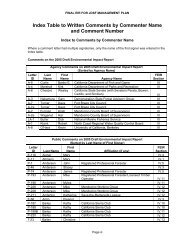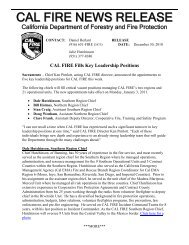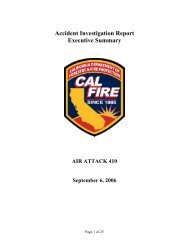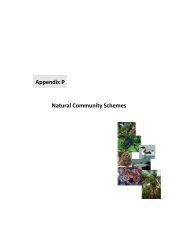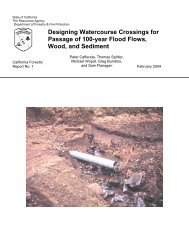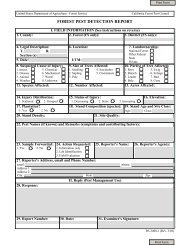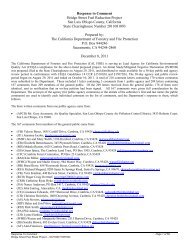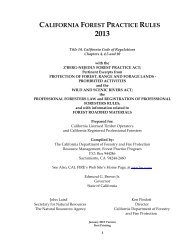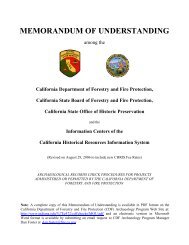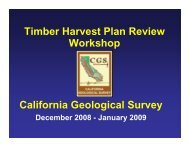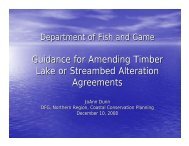Boggs Mountain Demonstration State Forest Draft ... - Cal Fire
Boggs Mountain Demonstration State Forest Draft ... - Cal Fire
Boggs Mountain Demonstration State Forest Draft ... - Cal Fire
You also want an ePaper? Increase the reach of your titles
YUMPU automatically turns print PDFs into web optimized ePapers that Google loves.
<strong>Boggs</strong> <strong>Mountain</strong> <strong>Demonstration</strong> <strong>State</strong> <strong>Forest</strong> <strong>Draft</strong> Management Plan, June 2008<br />
Geology<br />
Geologically, BMDSF is complex. The <strong>State</strong> <strong>Forest</strong> is on a lava cap area about one mile wide by<br />
3.5 miles long, forming a gently rolling summit with the sides breaking down into moderate to<br />
steep slopes. There are a few small areas of steep slopes and rock outcrops. Volcanic rocks are<br />
exposed over much of the forest. Andesites and basalts are visible as outcrops and along roads<br />
over most of the upper elevation, with the lower slopes of the northwest portion having volcanic<br />
rocks cap sandstones and mudstones.<br />
Water Resources<br />
BMDSF is a part of the top of <strong>Boggs</strong> Ridge, which is mostly a dry ridge top that runs<br />
northwest/southeast separating Putah Creek and Kelsey Creek watersheds. <strong>Boggs</strong> <strong>Mountain</strong> is<br />
part of the headwaters for the Kelsey Creek and Putah Creek drainages. Kelsey Creek is in the<br />
Clear Lake watershed; Putah Creek is in the Lake Berryessa watershed. Drainages on the forest<br />
are first and second order with no fisheries resources. Several landowners use water that comes<br />
directly from BMDSF. Most of these are in the east side of the forest including Ettawa Springs<br />
and Harbin Hot Springs. BMDSF has at least one easement for BMDSF water.<br />
Surface water is uncommon on the forest. There are 3.8 miles of perennial streams; portions of<br />
Grouse Spring, Houghton, Malo and Spikenard Creeks. Three springs exist on the forest: Big<br />
Springs, Bluff Springs and Houghton Springs have been developed to fill fire suppression storage<br />
tanks.<br />
Table 3. Perennial streams on BMDSF.<br />
Big Springs Creek<br />
.50 mi.<br />
Grouse Spring Creek<br />
.25 mi.<br />
Houghton Creek<br />
.76 mi.<br />
Malo Creek<br />
.76 mi.<br />
Mill Creek<br />
.76 mi<br />
Spikenard Creek<br />
1.14 mi.<br />
TOTAL<br />
3.8 mi.<br />
Roads<br />
An access road system based on the original logging road network was established shortly after<br />
the <strong>Forest</strong> was acquired. Starting in 1965, major portions of the original road system were rebuilt<br />
improving grades, alignment, and drainage. Some short sections of new roads were constructed<br />
to avoid adverse grade problems. The 22 mile road system consists of 12 miles of primary, allweather<br />
roads and 10 miles of secondary seasonal roads. No further additions to the road system<br />
are planned. Existing roads will be improved or decommissioned as funds and opportunities<br />
arise.<br />
All roads on BMDSF that are no longer required for management and recreational purposes will<br />
be considered for abandonment. Roads to be abandoned will include user-generated roads,<br />
temporary roads, and roads to be permanently closed. User-generated roads are those that<br />
vehicles have made by not following a recognized BMDSF road and creating tracks for others to<br />
follow. Temporary roads can be defined as roads that are used for one or two years for timber<br />
sale activity and then abandoned. They may be reopened and reused in the next timber sale<br />
entry.<br />
19



